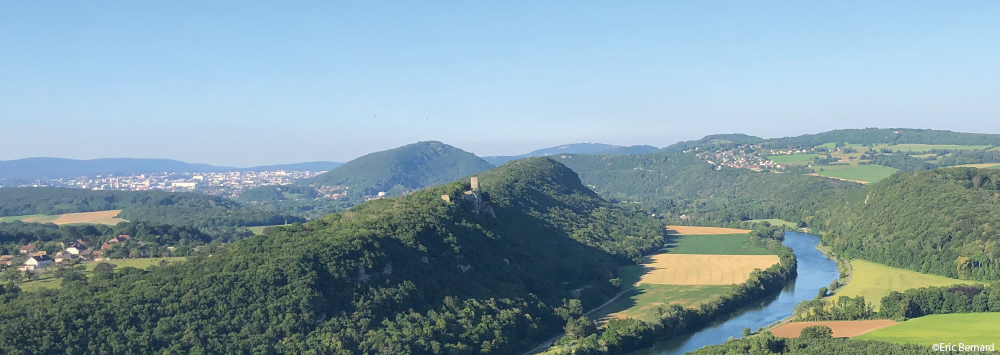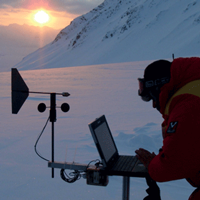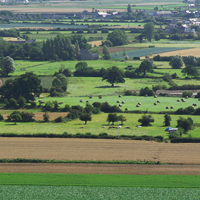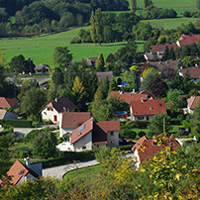
Landscape and living environment
This research group focuses on “landscapes” in all their dimensions: physical, material, visible, iconographic. Landscapes are primarily studied using quantitative approaches at various spatial and temporal timescales. The research is strongly multidisciplinary and embraces other subjects such as ecology, climatology, archaeology and the geosciences. In the face of growing social demand for “environment quality”, particularly the living environment, one of the aims of this research theme is to help urban planners.
Coordinator : Nick Marriner
Landscapes have long been studied by the geographers of ThéMA. This research focuses primarily on the development of methods to characterize the environment and landscapes, for example:
- designing visibility metrics to characterize landscapes
- designing graphic models to represent ecological networks
- image analysis to reconstruct and characterize the evolution of glacial and periglacial environments
- site instrumentation and data collection at high spatio-temporal resolution for model down/up-scaling
- the analysis of sedimentary archives to reconstruct the evolution of Holocene landscapes in coastal and fluvial contexts
The research then aims to understand different phenomena by using landscape metrics as explanatory factors:
- measure the landscape's contribution to the quality of residential environments
- identify the role of landscape connectivity in variations in biodiversity
- understand the adaptation of environments to climate change
- characterize anthropogenic impacts on landscapes over the long term
- quantify the impact of climate change at various spatio-temporal scales
Scientifics networks
GDR 3062 “Polar Mutations”. As part of the GDR “Mutations Polaires” network and the international Circumpolar Arctic Vegetation Map and Circumpolar Symposium on Remote Sensing of Polar Environment programs, ThéMA collaborates with Norwegian botanists from the University of Tromsø and with geographers from Toulouse and Clermont-Ferrand. The work focuses on two areas: the relationship between climate and vegetation and hydro-glacial flows.
International collaborations
Ain Shams University (Egypt): Coastal and fluvial palaeo-landscapes (Red Sea, Giza)
BOKU Universität für Bodenkultur (Austria) : Periglacial geomorphological studies/field measurements and LIDAR
Centre d'Etudes Alexandrines (Egypt) : Palaeoenvironments and landscape dynamics of the Nile Delta
Department of Classics & Archaeology, Université de Malte (Malta) : Studies of society-environment-climate interactions on the Maltese archipelago
University of Engineering and Management of the canton of Vaud (Suisse) : Acquisition and processing of data from online photography platforms
Iranian National Institute for Oceanography and Atmospheric Science (Iran) : Palaeoclimates and palaeoenvironments of the Persian Gulf
NPI - Norsk PolarInstitutt (Norway) : Ice and snow program in Svalbard
Université de Pise (Italy) : Relative sea-level changes in the Mediterranean
Université de Tromsø (Norway) : Within the framework of GDR 3062 “Polar Mutations”, the collaboration with Norwegian botanists focuses on the relationship between climate and vegetation
National collaborations
ARP-Astrance (Paris)
Dijon Métropole (Dijon) : Links between urban morphology and the diversity of pollinating insects
IPEV- Institut Paul Emile Victor (Brest) : Logistical support for fieldwork in the Arctic (study of geomorphological and hydrological dynamics of a polar hydro-system - Auster Lovénbreen observatory site, Svalbard, 79 ° N)
METEO France (Besançon) : Part # 1 vulnerability of the Jura forest to climate change / Part # 2 study of the spatio-temporal dynamics of snowpack in the middle Jura mountains
UMR Biogéosciences (Dijon) : Modeling of landscape connectivity applied to landscape ecology and genetics
UMR CEREGE (Aix-en-Provence) : Palaeoenvironmental evolution of coasts (Mediterranean, Black Sea, Red Sea)
UMR Environnement Ville Société (Lyon): Links between ecological networks and urban morphology
UMR FEMTO-ST University of Franche Comté (Besançon): Development of instruments to quantify, from sensor networks and samples, the liquid and solid flows of a polar hydro-system
UMR IGE University Grenoble Alpes (Grenoble): Contribution of radar remote sensing for the estimation of liquid and solid precipitation in the Alps and in the Arctic: observation, variability, impacts, coupled with field measurements
UMR IMBE (Aix-en-Provence): Paleoclimates and paleoenvironments of southern Iran and the Persian Gulf
UMR Ladyss (Paris): Applications of ecological network models
UMR LETG (University de Nantes): Coastal dynamics in Arctic environments. Coastal progradation and sediment budgets
UMR TRACES (Toulouse): Human-environment-climate interactions in the Mediterranean, palaeoecology
UR Lessem INRAE (Grenoble): Application of ecological network models to the reduction of ecological impacts
Local partnerships
CPEPESC- Commission for the Protection of Water, Heritage, Environment, Subsoil and Bats
DREAL de Bourgogne Franche-Comté - Regional Directorate for the Environment, Planning and Housing
LPO FC- League for the Protection of Birds of Franche-Comté
Rénover la gouvernance des forêts : approche comparée des filières forêt-bois européennes et d’Amérique du Sud par la modélisation de la qualité holistique du territoire.
Sindy Baron-Blanco - Direction : Damien Marage



